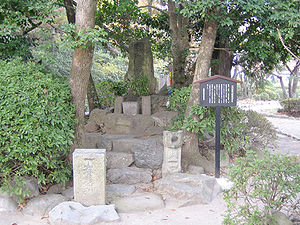- Battle of Okehazama
-
Battle of Okehazama Part of the Sengoku period 
The grave of Imagawa Yoshimoto, in Nagoya, near the site of the battle.Date May-June, 1560 Location Dengaku-hazama, Owari Province Result Decisive victory for Oda Belligerents Forces of Imagawa Yoshimoto Forces of Oda Nobunaga Commanders and leaders Imagawa Yoshimoto † Oda Nobunaga Strength Around 35,000 Around 2,500 Campaigns of Oda NobunagaCampaigns of Tokugawa IeyasuThe Battle of Okehazama (桶狭間の戦い Okehazama-no-tatakai) took place in June 1560. In this battle, Oda Nobunaga defeated Imagawa Yoshimoto and established himself as one of the front-running warlords in the Sengoku period.[citation needed]
Contents
Background
In May or June 1560, Imagawa Yoshimoto, with an army of perhaps 35,000 men, set forth on a march to Kyoto. Entering the Oda territories in Owari Province, he first took the border fortresses of Washizu and Marune before setting up camp in a wooded gorge known as Dengaku-hazama. This was all reported to Oda Nobunaga by his scouts and, in response, Nobunaga then led his own forces into position at a temple called Zenshōji, a short distance away, on the other side of the Tōkaidō.
Had Nobunaga decided on a frontal assault, the battle would have been deceptively easy to predict; his army was outnumbered ten to one by the Imagawa forces. A frontal assault would be suicidal and an attempt to hold out at Zenshō-ji would only last a few days. Because of the odds against their side, some of Nobunaga's advisers even suggested a surrender. Nobunaga, however, decided to launch a surprise attack on the Imagawa camp. When he made his decision, he gave this speech:
"Imagawa has 40,000 men marching toward this place? I don't believe that. He 'only' has 35,000 soldiers. Yes, that is still too many. So, Sado, you want me to surrender. What if we do surrender? Will you get content with losing your life that way? Or what if we hold on like Katsuie wants me to? What if we stay here in this castle, lock it up, and wait until the Imagawas lose appetite and stop the siege and go home? We will be able to prolong our lives for 5 or 10 days, and what we cannot defend will still be undefendable. We are at the bottom of the pit, you know. And our fate is interesting. Of course the misery is too great, too. But this is how I see it: this is a chance in a lifetime. I can't afford to miss this. Do you really want to spend your entire lives praying for longevity? We were born in order to die! Whoever is with me, come to the battlefield tomorrow morning. Whoever is not, just stay wherever you are and watch me win it!"
Battle
Nobunaga left a small force at the temple with a large number of banners, to give the impression that this was the location of his main force. Meanwhile, Oda's main force (about 1,500 men) moved through the forest undetected to the rear of the Imagawa army.
The Imagawa samurai did not expect an attack, and that afternoon was very hot. The histories say that the Imagawa were celebrating their recent victories with song, dance, and sake. An afternoon rainstorm further aided Oda's soldiers who arrived at the Imagawa camp just as the rains came down (this was the afternoon of 12 June).
When the storm passed, Nobunaga's men poured into the camp from the north, and the Imagawa warriors lost all discipline and fled from the attackers. This left their commander's tent undefended, and the Oda warriors closed in rapidly. Imagawa Yoshimoto, unaware of what had transpired, heard the noise and emerged from his tent shouting at his men to quit their drunken revelry and return to their posts. By the time he realized, moments later, that the samurai before him were not his own, it was far too late. He deflected one samurai's spear thrust, but was beheaded by another.
Aftermath
With their leader dead, and all but two of the senior officers killed, the remaining Imagawa officers joined Oda's army. Soon the Imagawa faction was no more and Oda Nobunaga was famous as his victory was hailed by many in Japan as miraculous. The most important of the samurai lords who joined Oda after this battle was Tokugawa Ieyasu from Mikawa Province. Ieyasu would remain a loyal ally of Nobunaga from this time until the latter's death.
List of notable samurai in the battle
- Oda side
- Imagawa side
- Imagawa Yoshimoto
- Asahina Yasutomo
- Okabe Motonobu
- Tokugawa Ieyasu
- Ii Naomori
- Honda Tadakatsu
- Hattori Hanzō
References
- Turnbull, Stephen (1987). 'Battles of the Samurai'. London: Arms and Armour Press.
Coordinates: 35°03′00.59″N 136°59′48.44″E / 35.0501639°N 136.9967889°E
Categories:- 1560 in Japan
- Battles involving Japan
- Conflicts in 1560
Wikimedia Foundation. 2010.
